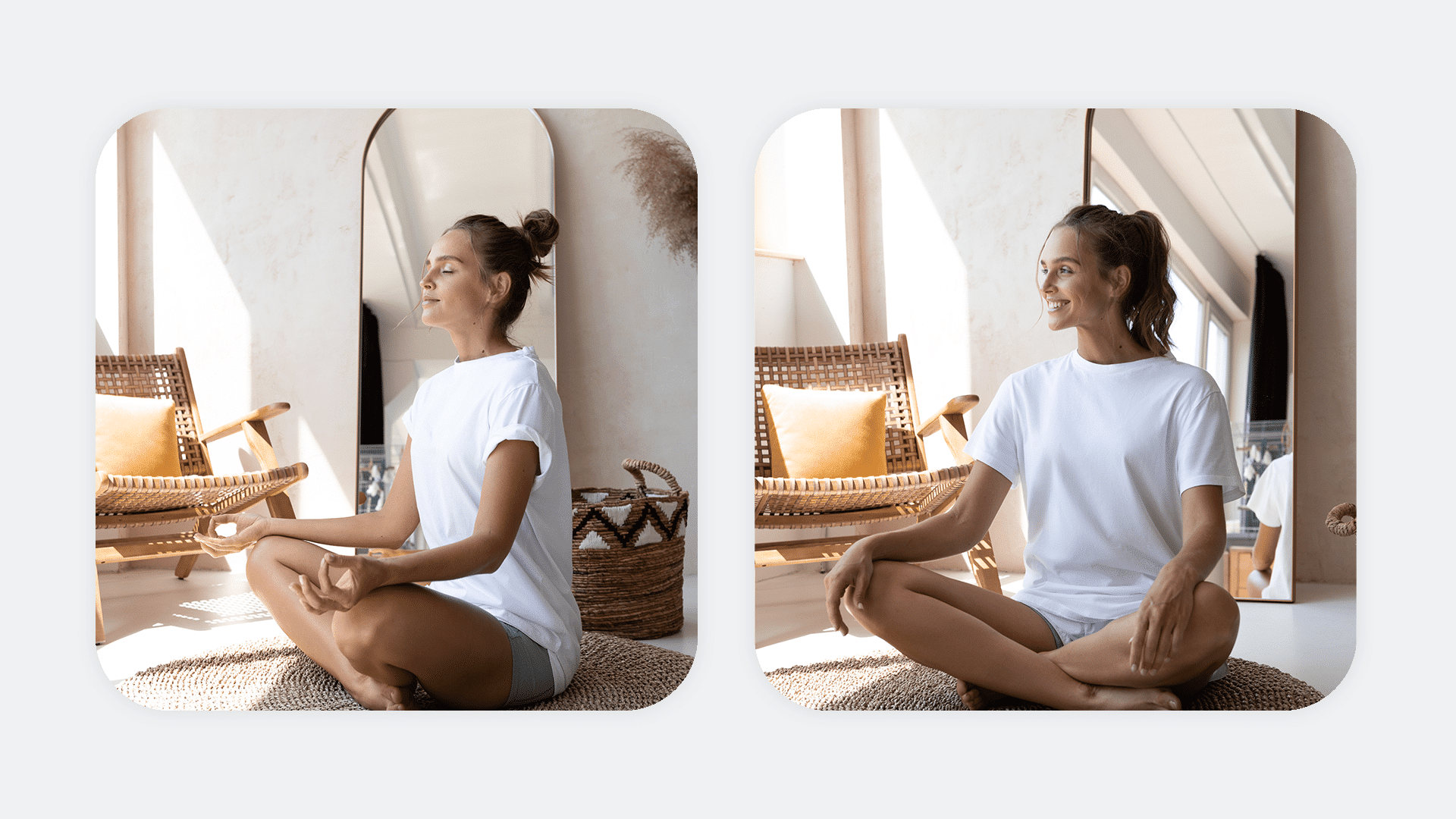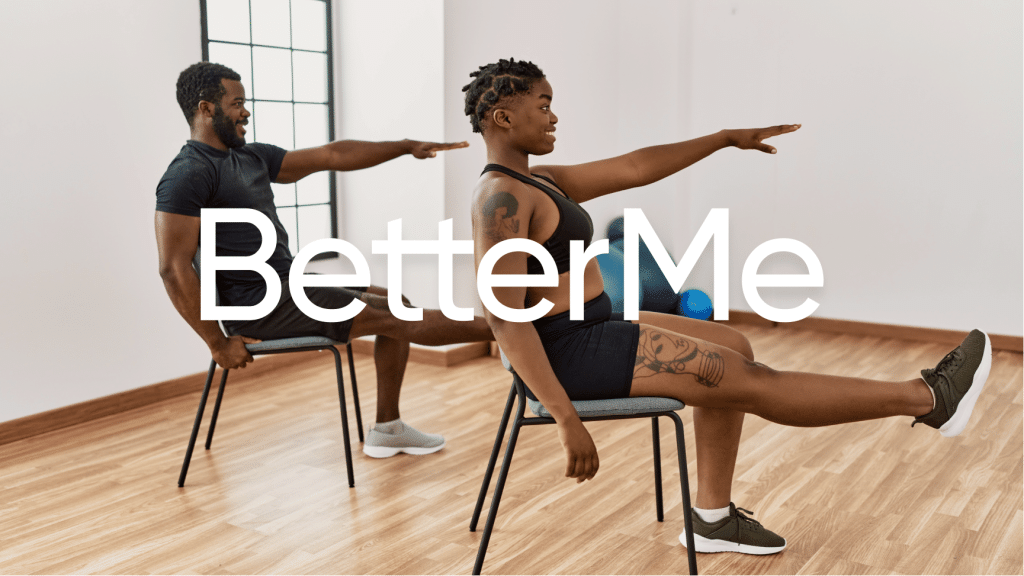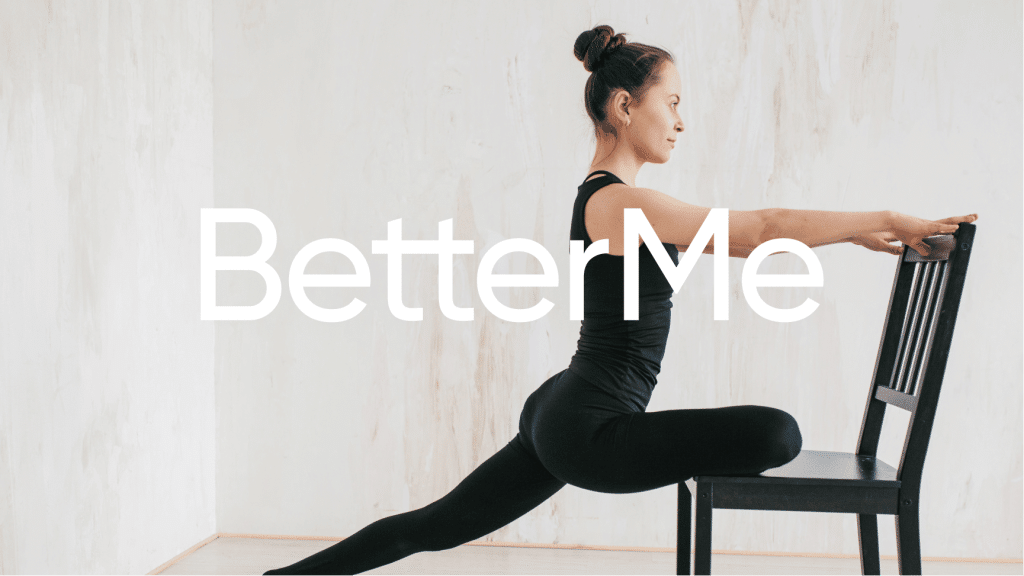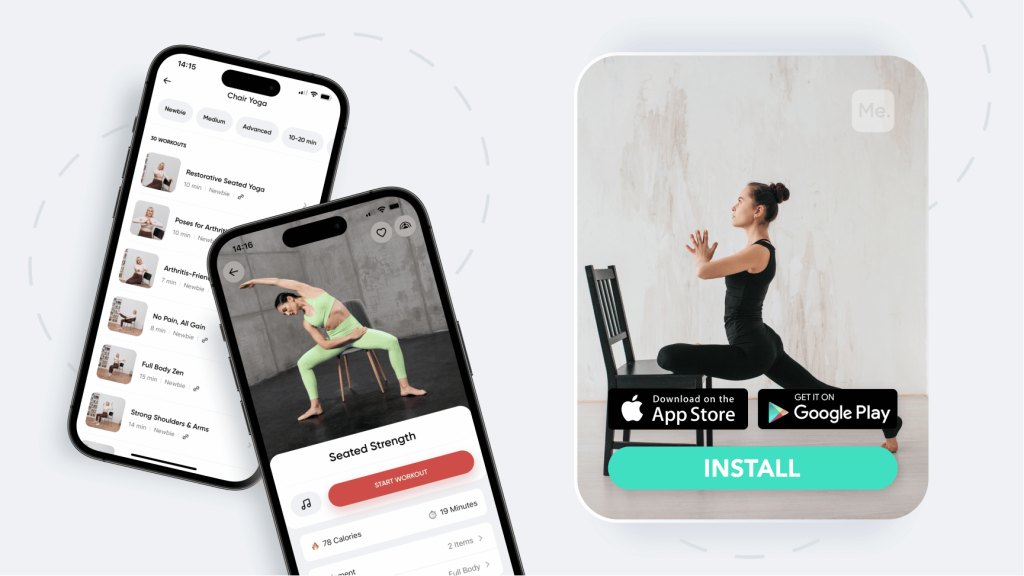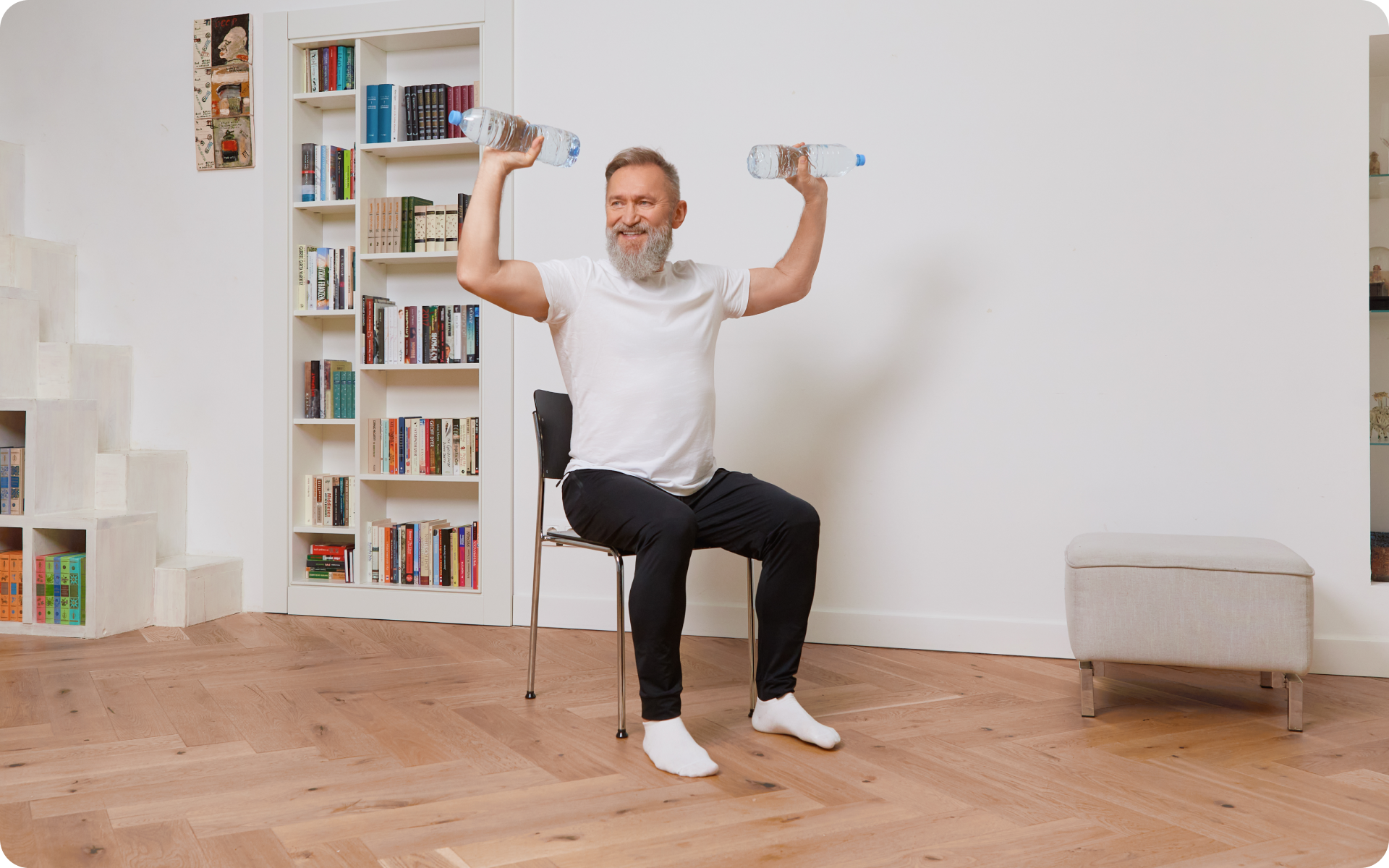Stress is a silent killer, affecting millions of people worldwide. In fact, the World Health Organization has called it the “health epidemic of the 21st century.” According to recent statistics, 77% experience physical symptoms caused by stress, and 73% experience psychological symptoms.
It’s no wonder many of us are searching for ways to unwind and rejuvenate our minds and bodies. This comprehensive guide is designed to introduce you to the world of chair yoga, a powerful yet accessible practice that can be done in the comfort of your own home or office.
With benefits such as improved circulation, increased flexibility, and a more relaxed mind and body, chair yoga has the potential to change your life for the better.
Throughout this blog post we’ll walk you through the steps, techniques, and tips you need to effectively incorporate chair yoga into your daily routine, leaving you feeling refreshed and ready to tackle whatever life throws at you.
How Does Chair Yoga Reduce Stress?
Chair yoga is a modified version of traditional yoga that can be practiced while sitting on a chair or using it for support. This form of yoga is particularly beneficial for those who have mobility issues or are unable to engage in regular yoga. The practice of chair yoga has been proven to reduce stress through several key mechanisms, which we will explore in detail below.
Activation Of The Relaxation Response
When practicing chair yoga, you engage in deep breathing exercises, which help activate the body’s relaxation response (1).
This physiological reaction is the opposite of a stress response, also known as the “fight or flight” response.
During a relaxation response, your heart rate slows down, blood pressure decreases, and muscle tension releases, leading to a state of calm and relaxation.
Release Of Feel-Good Hormones
Chair yoga stimulates the release of endorphins, serotonin, and oxytocin – hormones that are responsible for producing feelings of happiness, well-being, and relaxation (2).
By increasing the levels of these feel-good hormones, chair yoga helps counteract the negative effects of stress hormones such as cortisol and adrenaline.
Read More: 12 Office Chair Yoga Exercises For When You’ve Had A Long Day At Work
Improved Mind-Body Connection
Through gentle stretching and mindful movement, chair yoga strengthens the connection between the mind and body. This enhanced awareness enables practitioners to better identify and manage stress triggers, ultimately reducing their overall stress levels (2).
Enhanced Self-Efficacy And Empowerment
Chair yoga helps build self-efficacy by allowing practitioners to successfully complete poses and exercises that they might not have thought possible. This sense of accomplishment and empowerment contributes to increased confidence and a more positive outlook, which can help reduce stress levels (1).
Increased Mindfulness And Present Moment Awareness
Chair yoga encourages mindfulness by directing attention to the present moment and focusing on breath and body sensations. This increased awareness of the present helps to distance oneself from stress-inducing thoughts or worries about the past and future.
Cultivation Of Gratitude And Compassion
Practicing chair yoga often involves setting an intention or dedicating the practice to someone or something meaningful. This process fosters gratitude and compassion, which are powerful antidotes to stress. A positive and compassionate mindset can help alleviate feelings of stress and promote emotional well-being.
Social Connection And Support
Participating in chair yoga classes or group sessions provides an opportunity for social connection and support. Engaging with others who share similar goals and challenges can create a sense of belonging and camaraderie, which has been shown to help reduce stress and improve overall mental health (1).
Improved Sleep Quality
Regular practice of chair yoga has been associated with better sleep quality. As sleep plays a crucial role in stress management and overall well-being, improved sleep patterns can contribute significantly to stress reduction (1).
BetterMe app is a foolproof way to go from zero to a weight loss hero in a safe and sustainable way! What are you waiting for? Start transforming your body now!
Is Chair Yoga As Beneficial As Regular Yoga For Stress Relief?
Chair yoga and regular yoga share many similarities in terms of stress relief benefits. While both practices incorporate breathwork, mindfulness, and physical postures, there are some differences in their approach and accessibility that may influence their effectiveness for stress relief on an individual basis.
Similarities In Stress Relief Benefits
Both chair yoga and regular yoga focus on deep breathing exercises, which activate the relaxation response and promote a sense of calm (1).
They also encourage mindfulness and present moment awareness, helping practitioners distance themselves from stress-inducing thoughts.
Additionally, both forms of yoga involve gentle stretching and mindful movement, which can release muscle tension and foster a stronger mind-body connection.
Differences In Approach And Accessibility
The primary difference between chair yoga and regular yoga is how a chair is used as a prop to modify traditional yoga poses.
This modification makes chair yoga more accessible for individuals with limited mobility, balance issues, or other physical limitations that might prevent them from fully participating in regular yoga classes (2).
For those who face such challenges, chair yoga might be more beneficial for stress relief because it allows them to engage in a yoga practice without experiencing frustration or discomfort.
In this case, the accessibility of chair yoga can lead to a greater sense of accomplishment, empowerment, and stress reduction.On the other hand, regular yoga offers a wider range of poses and sequences that can target different areas of tension in the body more effectively.
For individuals who are able to comfortably perform regular yoga poses, regular yoga may be more beneficial for stress relief due to the greater variety and intensity of the practice.
Individual Factors And Preferences
Ultimately, whether chair yoga or regular yoga is more beneficial for stress relief depends on individual factors and preferences.
Some people might find chair yoga more suitable due to its gentle nature and accessibility, while others might prefer the challenge and variety offered by regular yoga.
The key is to find a practice that resonates with you and supports your unique needs and goals.
Read More: Unlocking Relaxation: The Magic Of Restorative Chair Yoga
Which Chair Yoga Exercise Is Best For Stress Relief?
The best chair yoga exercise for stress relief is one that combines breathing, mindfulness, and gentle movements that target areas of physical tension.
1. Chair Cat-Cow Stretch (Marjaryasana-Bitilasana)
The Cat-Cow stretch is a combination of two poses that help relieve tension in the neck, shoulders, and spine. This gentle movement promotes spinal flexibility, which can alleviate stress-related discomfort.
How to do it:
- Sit on a chair with your feet flat on the floor, hip-width apart.
- Place your hands on your knees.
- As you inhale, arch your spine and look up towards the ceiling (Cow pose).
- As you exhale, round your spine, tuck your chin towards your chest, and draw your navel inward (Cat pose).
- Repeat this sequence 5-10 times.
2. Chair Forward Bend (Uttanasana)
The Forward Bend helps to calm the nervous system, promoting relaxation and stress relief. It stretches the spine and hamstrings, releasing tension in the lower back and legs.
How to do it:
- Sit at the edge of the chair, feet hip-width apart.
- Inhale and lengthen your spine.
- As you exhale, fold forward from your hips, allowing your upper body to relax over your thighs.
- Hold onto your elbows or let your hands rest on the floor.
- Hold for 5-10 breaths.
3. Chair Seated Spinal Twist (Ardha Matsyendrasana)
Twisting poses like Seated Spinal Twist help to release tension in the spine, shoulders, and hips. They also stimulate digestion and detoxification, which can be beneficial for stress relief.
How to do it:
- Sit sideways on the chair, with your right hip against the chair back.
- Inhale and lengthen your spine.
- As you exhale, twist your torso to the right, holding onto the chair back for support.
- Hold for 5-10 breaths, then switch sides.
Intense sweat sessions, working weight loss tips, lip-smacking recipes come in one package with the BetterMe app. And all of it is at your fingertips, start transforming your life now!
4. Chair Eagle Arms (Garudasana)
Eagle Arms can help to release tension in the shoulders and upper back, which are common areas where stress accumulates.
How to do it:
- Sit tall on the chair, feet flat on the floor.
- Extend your arms in front of you at shoulder height.
- Cross your right arm over your left, bending your elbows and bringing the backs of your hands together.
- If possible, wrap your hands further so that your palms touch.
- Hold for 5-10 breaths, then switch sides.
5. Chair Pigeon Pose (Eka Pada Rajakapotasana)
Pigeon Pose is a hip-opening posture that helps release tension and stress stored in the hips and lower body.
How to do it:
- Sit on the edge of the chair, feet flat on the floor.
- Place your right ankle on your left thigh, just above the knee.
- Keep your right foot flexed to protect your knee.
- Gently press your right knee down and hinge forward at your hips to increase the stretch.
- Hold for 5-10 breaths, then switch sides.
6. Chair Legs-Up-The-Wall Pose (Viparita Karani)
This restorative pose promotes relaxation by reversing blood flow and encouraging lymphatic drainage. This can help alleviate stress-related symptoms such as fatigue and anxiety.
How to do it:
- Position your chair near a wall.
- Sit sideways on the chair, with your right hip close to the wall.
- Swing your legs up onto the wall as you lower your upper body onto the chair seat.
- Adjust your position so that your legs are fully supported by the wall and your torso is comfortably resting on the chair.
- Close your eyes and breathe deeply, holding the pose for 5-10 minutes.
7. Chair Child’s Pose (Balasana)
Child’s Pose is a calming and grounding posture that helps to release tension in the back, shoulders, and hips.
How to do it:
- Sit at the edge of the chair, feet hip-width apart.
- Open your knees wide and hinge forward from your hips, allowing your torso to rest between your thighs.
- Extend your arms forward, resting your forearms on a desk or table.
- Hold for 5-10 breaths.
8. Chair Supported Fish Pose (Matsyasana)
Supported Fish Pose opens up the chest and shoulders, counteracting the effects of stress-related tension and encouraging deep breathing.
How to do it:
- Place a folded blanket or cushion on the chair seat.
- Sit on the edge of the chair with your feet flat on the floor.
- Lower your upper body onto the support, allowing your chest to open and your head to relax back.
- Extend your arms out to the sides, palms facing up.
- Hold for 5-10 breaths.
9. Chair Seated Mountain Pose (Tadasana)
Seated Mountain Pose encourages proper posture and alignment, helping to alleviate stress-related tension in the neck, shoulders, and back.
How to do it:
- Sit tall on the chair, feet flat on the floor.
- Lengthen your spine, engage your core muscles, and relax your shoulders down and away from your ears.
- Rest your hands on your thighs or by your sides, palms facing up.
- Close your eyes and take slow, deep breaths, focusing on your posture and alignment.
10. Chair Seated Meditation (Dhyana)
Meditation is a powerful tool for reducing stress and promoting relaxation. Practicing meditation in a seated position can help improve focus and concentration.
How to do it:
- Sit comfortably on the chair, with your feet flat on the floor and your spine tall and straight.
- Close your eyes and bring your attention to your breath.
- Observe your inhalations and exhalations without trying to change them. If your mind wanders, gently bring your focus back to your breath.
- Practice for 5-10 minutes or longer, as desired.
Sample Chair Yoga Routines For Stress Relief
Here are two sample chair yoga routines for stress relief, designed to accommodate different time constraints and preferences. Each routine includes a combination of poses that target various areas of tension, promote relaxation, and encourage mindfulness.
10-Minute Chair Yoga Routine For Stress Relief
- Chair Cat-Cow Stretch (Marjaryasana-Bitilasana): 1 minute
- Chair Seated Mountain Pose (Tadasana): 1 minute
- Chair Forward Bend (Uttanasana): 1 minute
- Chair Eagle Arms (Garudasana): 1 minute on each side
- Chair Seated Spinal Twist (Ardha Matsyendrasana): 1 minute on each side
- Chair Seated Meditation (Dhyana): 2 minutes
20-Minute Chair Yoga Routine For Stress Relief
- Chair Cat-Cow Stretch (Marjaryasana-Bitilasana): 2 minutes
- Chair Seated Mountain Pose (Tadasana): 2 minutes
- Chair Forward Bend (Uttanasana): 2 minutes
- Chair Eagle Arms (Garudasana): 2 minutes on each side
- Chair Pigeon Pose (Eka Pada Rajakapotasana): 2 minutes on each side
- Chair Seated Spinal Twist (Ardha Matsyendrasana): 2 minutes on each side
- Chair Child’s Pose (Balasana): 2 minutes
- Chair Seated Meditation (Dhyana): 4 minutes
How To Use Chair Yoga For Stress Relief
Here’s how to get started with chair yoga and a few helpful tips to make your practice effective and enjoyable.
Step 1: Create A Comfortable Space
Find a quiet and comfortable space where you can practice chair yoga without distractions. Ensure that the area has enough room for you to move freely and safely. You will need a sturdy chair without wheels, preferably one with a straight back. Remove any obstacles or clutter from the space to minimize distractions.
Step 2: Dress Comfortably
Wear comfortable, loose-fitting clothing that allows for easy movement. Avoid tight or constricting garments which could limit your range of motion or cause discomfort during your practice.
Step 3: Warm-Up
Begin your chair yoga practice with a gentle warm-up to prepare your mind and body for the poses. Start with some neck rolls, shoulder shrugs, and wrist circles to release any tension and increase blood flow to the muscles.
Step 4: Choose Your Poses
Select a series of chair yoga poses that target areas of tension and stress in your body. Refer to the sample routines provided earlier in this discussion or create your own sequence based on your individual needs and preferences. Aim for a balanced practice that includes forward bends, twists, and stretches for the neck, shoulders, hips, and spine.
Step 5: Focus On Your Breath
Throughout your practice, maintain a consistent focus on your breath. Deep, slow breaths can help activate the relaxation response and promote stress relief. Try to synchronize your breath with your movements – inhaling as you lengthen or expand, and exhaling as you fold or contract.
Step 6: Hold Each Pose Mindfully
Hold each pose for 5-10 breaths, or longer if desired. As you hold the pose, bring your awareness to the sensations in your body and any areas of tension or discomfort. Use your breath to help release tension and deepen the stretch.
Step 7: Modify As Needed
Listen to your body and modify the poses as necessary to accommodate your physical limitations or discomfort. Use props such as cushions, blankets, or blocks to provide additional support and make the poses more accessible.
Step 8: End With Relaxation And Meditation
Conclude your chair yoga practice with a period of relaxation and meditation. Sit comfortably on your chair, close your eyes, and take slow, deep breaths. Allow your body to fully relax and release any remaining tension. You may choose to practice guided meditation or simply focus on your breath for several minutes.
Step 9: Practice Regularly
For optimal stress relief benefits, incorporate chair yoga into your daily routine. Consistent practice will help increase your flexibility, strength, and mindfulness, leading to more effective stress management and overall well-being.
Step 10: Adjust Your Practice Over Time
As your needs and preferences change, adjust your chair yoga practice accordingly. Explore new poses and sequences, modify the duration of your practice, and experiment with different relaxation and meditation techniques to keep your practice fresh and engaging.
By following this practical guide, you can effectively use chair yoga for stress relief and enjoy the numerous physical, mental, and emotional benefits it has to offer. Remember that consistency is the key and that finding a practice that resonates with you will yield the best results.
When To Use Chair Yoga For Stress Relief?
Knowing when to use chair yoga for stress relief can help maximize its benefits and support your overall well-being. Here are some ideal times to incorporate chair yoga into your routine:
1. Morning Routine
Practicing chair yoga in the morning can help set a positive tone for the day and reduce any lingering stress or tension from the previous day or night. It can also help you feel more focused and energized for the day ahead.
2. Midday Break
Taking a break during your workday to practice chair yoga can help alleviate stress and tension that may accumulate throughout the day. It can also serve as a mental reset, allowing you to return to your tasks with a clear mind and renewed energy.
3. After Work
Practicing chair yoga after work can help you unwind and transition from your work environment to your personal life. This can be particularly helpful if you have a stressful job or if you tend to bring work-related stress home with you.
4. Before Bedtime
Engaging in a gentle chair yoga practice before bedtime can help calm your mind and prepare your body for sleep. This can be especially beneficial if you experience stress-related insomnia or have difficulty winding down at the end of the day.
5. During Stressful Events
If you find yourself in a stressful situation, taking a few minutes to practice chair yoga can help you regain a sense of calm and control. Focusing on your breath and performing gentle stretches can reduce anxiety and help you feel more grounded.
6. As Needed
Listen to your body and practice chair yoga whenever you feel the need for stress relief. This can vary from person to person and may depend on factors such as your stress levels, physical health, and personal preferences.
Conclusion
Incorporating chair yoga into your daily routine can be a highly effective way to combat stress and promote overall well-being.
By creating a comfortable space, choosing appropriate poses, focusing on your breath, and practicing regularly, you can harness the numerous physical, mental, and emotional benefits that chair yoga has to offer.
With its accessibility and adaptability, chair yoga is an ideal practice for individuals of all ages and abilities, seeking relief from stress and a greater sense of balance in their lives.
DISCLAIMER:
This article is intended for general informational purposes only and does not serve to address individual circumstances. It is not a substitute for professional advice or help and should not be relied on for making any kind of decision-making. Any action taken as a direct or indirect result of the information in this article is entirely at your own risk and is your sole responsibility.
BetterMe, its content staff, and its medical advisors accept no responsibility for inaccuracies, errors, misstatements, inconsistencies, or omissions and specifically disclaim any liability, loss or risk, personal, professional or otherwise, which may be incurred as a consequence, directly or indirectly, of the use and/or application of any content.
You should always seek the advice of your physician or other qualified health provider with any questions you may have regarding a medical condition or your specific situation. Never disregard professional medical advice or delay seeking it because of BetterMe content. If you suspect or think you may have a medical emergency, call your doctor.
SOURCES:
- 9 Benefits of Yoga (n.d., hopkinsmedicine.org)
- Effects of a chair-yoga exercises on stress hormone levels, daily life activities, falls and physical fitness in institutionalized older adults (2016, nih.gov)
